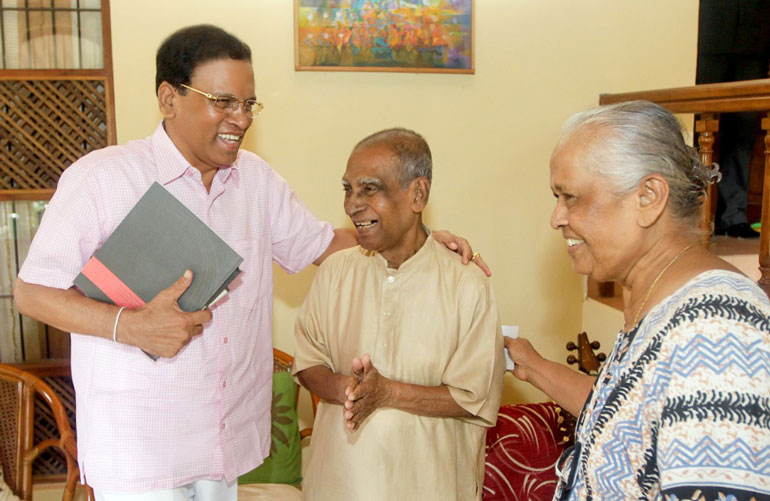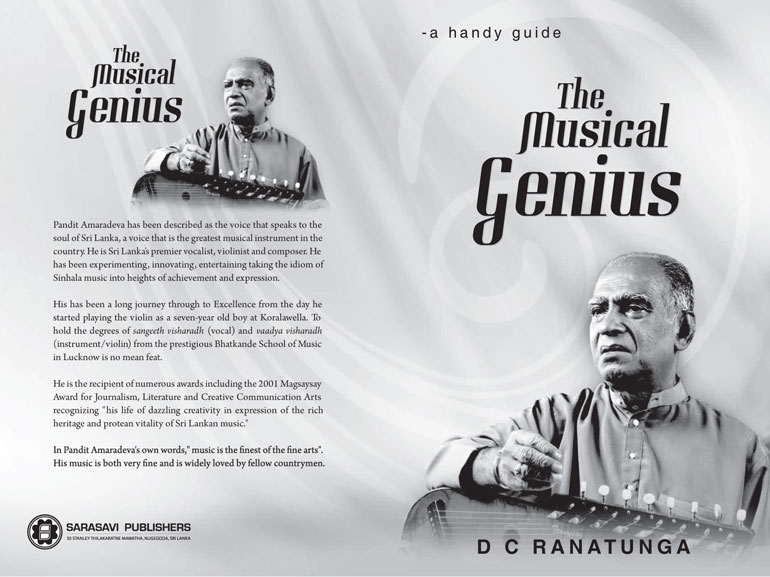Saturday Nov 29, 2025
Saturday Nov 29, 2025
Saturday, 10 October 2015 00:00 - - {{hitsCtrl.values.hits}}

It was a fine gesture on the part of President Sirisena to visit maestro Pandit Amaradeva a few days back. He dropped in at the Pandit’s residence to see how he was getting on. Pandit Amaradeva had returned after a fairly strenuous tour in Australia.
I remember how the President recalled his association with Pandit Amaradeva in his first TV interview when he said he liked Amaradeva’s patriotic song ‘Ratnadeepa Janmabhumi’ very much. He remembered how he used to take Amaradeva to Polonnaruwa and how both of them sat on the bund of Parakrama Samudra and chatted for hours. Even more than his music, the President was most impressed with the maestro’s deep knowledge of the Sinhala language. 
As for his Australian tour, I saw how Sri Lankans in Sydney turned in their numbers to fill The Concourse Concert Hall at Chelwood to listen to Pandit Amaradeva. They knew it would, in all probability, be his last overseas tour. As he walked in, helped by son Ranjana, he was welcomed by a roaring applause which he acknowledged before sitting down to commence ‘Sasara vasana thuru’ – the name adapted for his concerts in recent times.
Starting with ‘Jagan Mohini’ – the song that Sri Chandraratne Manawasinghe created for the inaugural Sarasaviya Film Awards in the early 1960s to pay homage to goddess Saraswathie – he sang most of the popular numbers. In between he paid a glowing tribute to Khemadasa Master for the latter’s innovative flair and the immense service he rendered in creating a new trend in Sinhala film music. Fond memories were revived through a video clip featuring the two of them in the studio recording film songs. K.A.W. Perera’s ‘Senasuma Kothanada’ was the film for which Amaradeva sang the first song for Khemadasa.
Pandit Amaradeva’s was a great effort that evening to keep up to the high standards he always maintained. He did find it difficult in a few places but the audience didn’t mind it. The way he still managed to keep up to the high pitches he has been used to, was quite creditable. He got up many a time to get the climax of a song the way he was used to. He related many an interesting anecdote.
His selection of songs that evening was also, in a way, a tribute to the renowned lyricists of his day. From Manawasinghe’s ‘Jagan Mohini’ to Madawala S Ratnayake’s ‘Pile Pedura’ to Mahagama Sekera’s ‘Sannaliyane’, it was a memorable musical journey for Amaradeva which gave listeners the best of Sinhala music over the air waves of Radio Ceylon/SLBC at a time when there was no television. That’s why musical programmes like ‘Madhuvanti’ and ‘Jana Gayana’ remain landmarks on Sri Lanka’s music scene.
The show climaxed with the ever-popular numbers – ‘Shanta Me Re Yame’ and ‘Peenamuko Kalugange’, with the audience joining in to make it a memorable evening. No one was allowed to meet him and he was whisked away immediately after the show. It was quite tiring for him.
I met him the next day at leisure and had a chat about the old days. I was happy that he was getting a long break before going to Brisbane for the next show and from there to Melbourne and to Perth before getting back home. I felt relieved to see him in his usual easy style when he met the President who, it was reported, spent time with him humming a few songs as well.
On a personal note. I remembered the day I went over to his home two years ago on his birthday on 5 December with Sarasavi Publishers head, H.D. Premasiri, to present him the first copy of ‘The Musical Genius’ I authored as a tribute to the maestro. It happened to be the only book done on him in English though a wide English readership is among his fans.
The many journals written about him and the souvenirs published for his performances are in Sinhala with one or two English articles thrown in. It’s time the Amaradeva Foundation publishes a collection of those articles written by Dr. Carlo Fonseka and other writers for the benefit of the English readership and researchers.
